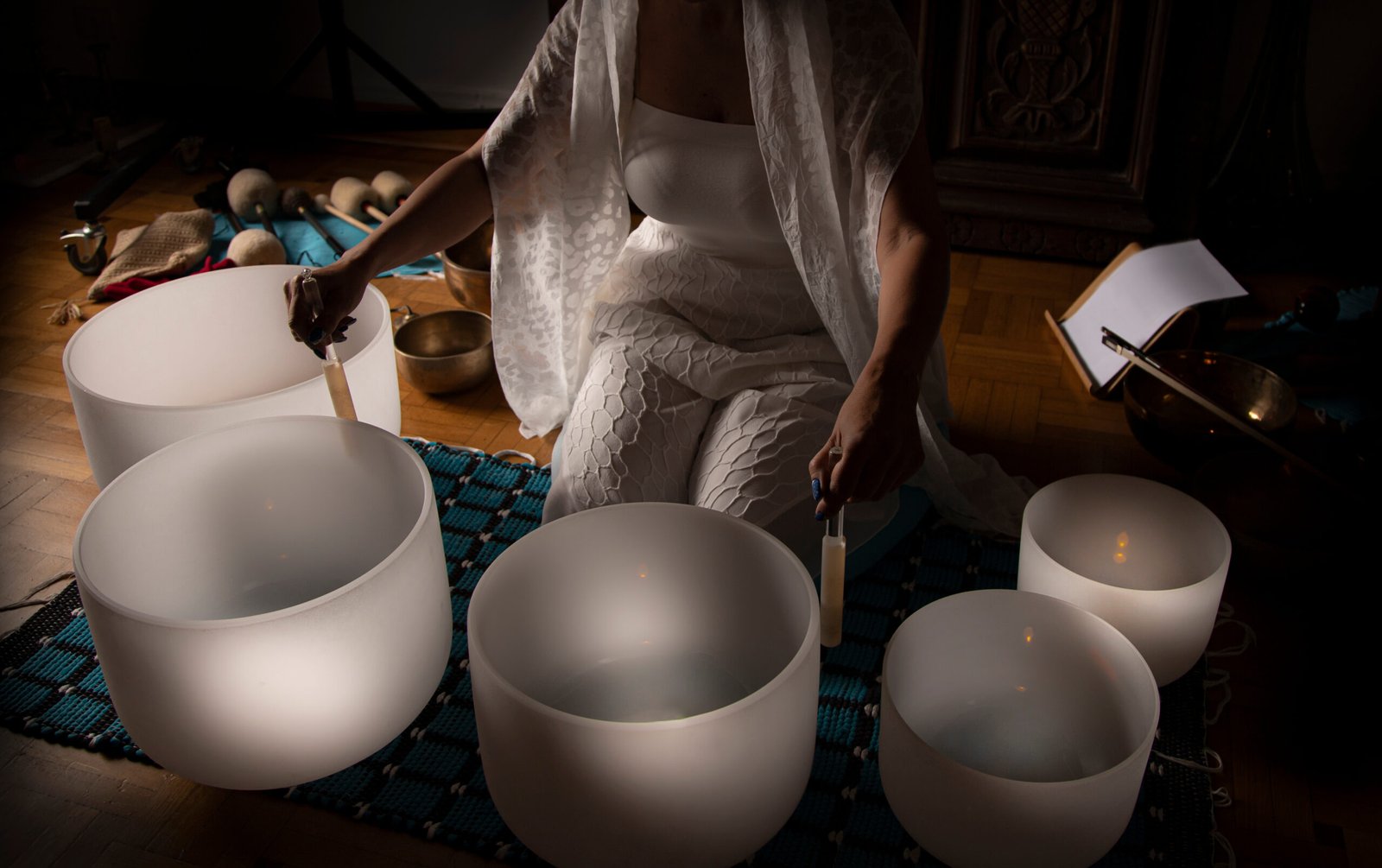Crystal singing bowls emit pure vibrational frequencies that can profoundly impact your physical and energetic wellbeing. Yet, if you’re new to sound therapy, you might unknowingly compromise these healing benefits through common technical mistakes. From improper striking techniques to misaligned bowl positioning, these errors can transform a potentially therapeutic session into an ineffective or even counterproductive experience. Understanding these essential missteps will help you access the full therapeutic potential of your sound healing practice.
Key Takeaways
Striking bowls too hard can create micro-fractures and chaotic vibrations, so use gentle movements with a suede or rubber mallet instead.
Place bowls on stable surfaces with proper cushioning at chest level, keeping them away from walls and 12 inches apart.
Clean bowls regularly with purified water and microfiber cloth, storing them in padded cases away from sunlight and extreme temperatures.
Select bowls with complementary frequencies and notes within the same scale to avoid dissonance and maintain therapeutic harmony.
Allow sufficient time for sound healing sessions, typically 45-60 minutes, with mindful pacing and attention to client responses.
Striking Your Bowl Too Forcefully
When practitioners strike their crystal singing bowls with excessive force, they risk damaging both the instrument and compromising its therapeutic benefits. The delicate crystalline structure requires gentle, controlled movements to produce ideal sound vibration effects. You’ll want to use a suede or rubber mallet with precise bowl striking techniques that focus on intention rather than power.
If you’re striking too hard, you’ll notice harsh, jarring sounds instead of the pure, resonant tones that facilitate healing. This aggressive approach can create micro-fractures in your bowl, ultimately shortening its lifespan and altering its frequency. Additionally, forceful strikes generate chaotic vibrations that may disturb your client’s energy field rather than harmonize it.
To achieve the best results, maintain a light touch and let the bowl’s natural resonance build gradually. Your mallet should make contact with the rim using minimal pressure, allowing the crystal’s inherent properties to generate therapeutic frequencies.
Improper Bowl Placement and Positioning
Proper bowl placement serves as the foundation for effective crystal singing bowl therapy, much like the gentle striking technique. When you position your bowl incorrectly, you’ll compromise both sound quality and therapeutic benefits. Place your bowl on a flat, stable surface using a proper rubber ring or cushion to prevent unwanted vibration dampening.
For ideal sound positioning, make certain your bowl sits at chest or heart level when you’re seated. You’ll want to maintain a 45-degree angle between your mallet and the bowl’s rim, allowing for smooth, controlled movements. Don’t place your bowl too close to walls or corners, as this can create sound distortion and affect the bowl’s natural resonance.
If you’re working with multiple bowls, space them at least 12 inches apart to prevent interference patterns. This correct bowl placement enables each vessel to produce its pure, intended frequency without disruption from neighboring bowls.
Neglecting Bowl Care and Maintenance
Just as your singing bowl represents a significant investment in healing practice, maintaining its pristine condition guarantees maximum therapeutic benefits and longevity. Regular bowl cleaning and proper storage aren’t just about aesthetics – they’re essential for maintaining frequency alignment and sound quality. You’ll notice diminished therapeutic results when your bowl accumulates oils, fingerprints, or dust, which can interfere with its vibrational properties.
- Store your crystal singing bowl in a padded case away from direct sunlight and extreme temperatures to prevent potential cracking or degradation of its crystalline structure
- Clean your bowl before and after each session using purified water and a microfiber cloth, avoiding harsh chemicals that could damage the bowl’s surface or alter its frequency
- Periodically check for tiny chips or cracks, as these imperfections can affect the bowl’s resonance and potentially compromise its therapeutic effectiveness during sound healing sessions
Mixing Incompatible Frequencies and Notes
While crystal singing bowls can create beautiful harmonies when played together, combining incompatible frequencies can disrupt the therapeutic benefits and create dissonant vibrations that may affect your client’s healing experience.
To maintain frequency harmony, you’ll need to understand the basic principles of note compatibility. Start by selecting bowls that are tuned to complementary notes within the same scale. For instance, combining C and G creates a perfect fifth, while C and F produce a perfect fourth – both pleasant and therapeutically effective combinations.
Don’t mix bowls with drastically different frequencies or those that create minor second intervals, as these can generate uncomfortable tension. Instead, focus on harmonic relationships that support your therapeutic goals. You’ll achieve better results by using bowls tuned to notes that naturally resonate together, such as those following the Circle of Fifths or traditional chakra-based arrangements.
Rushing Through the Sound Healing Process
Sound healing requires patience and intentional pacing to achieve its therapeutic potential. When you rush through your crystal bowl sessions, you’ll miss the deeper resonant frequencies that take time to develop and integrate within the body’s energy systems. The most effective sound duration allows for complete vibrational immersion, typically lasting 45-60 minutes per session.
- Begin with mindful breathing exercises for at least 5 minutes before playing the bowls to ground yourself and your client
- Allow each note to fully develop and fade naturally before shifting to the next tone, maintaining a 30-45 second hold
- Observe your client’s responses and adjust the pacing accordingly, watching for signs of overwhelm or need for extended resonance
Remember that therapeutic sound healing isn’t about quantity but quality of vibration. Your careful attention to timing creates space for cellular restoration and energetic rebalancing, making each session more effective and transformative.
Conclusion
You’ll find it ironic that while crystal singing bowls offer profound healing through their gentle vibrations, most beginners compromise their therapeutic potential through forceful handling and rushed sessions. By avoiding these five fundamental mistakes, you’re not just preserving your instruments – you’re safeguarding the very essence of sound therapy. Remember: the bowls’ transformative power lies not in their volume, but in your mindful, patient approach to their sacred frequencies.




